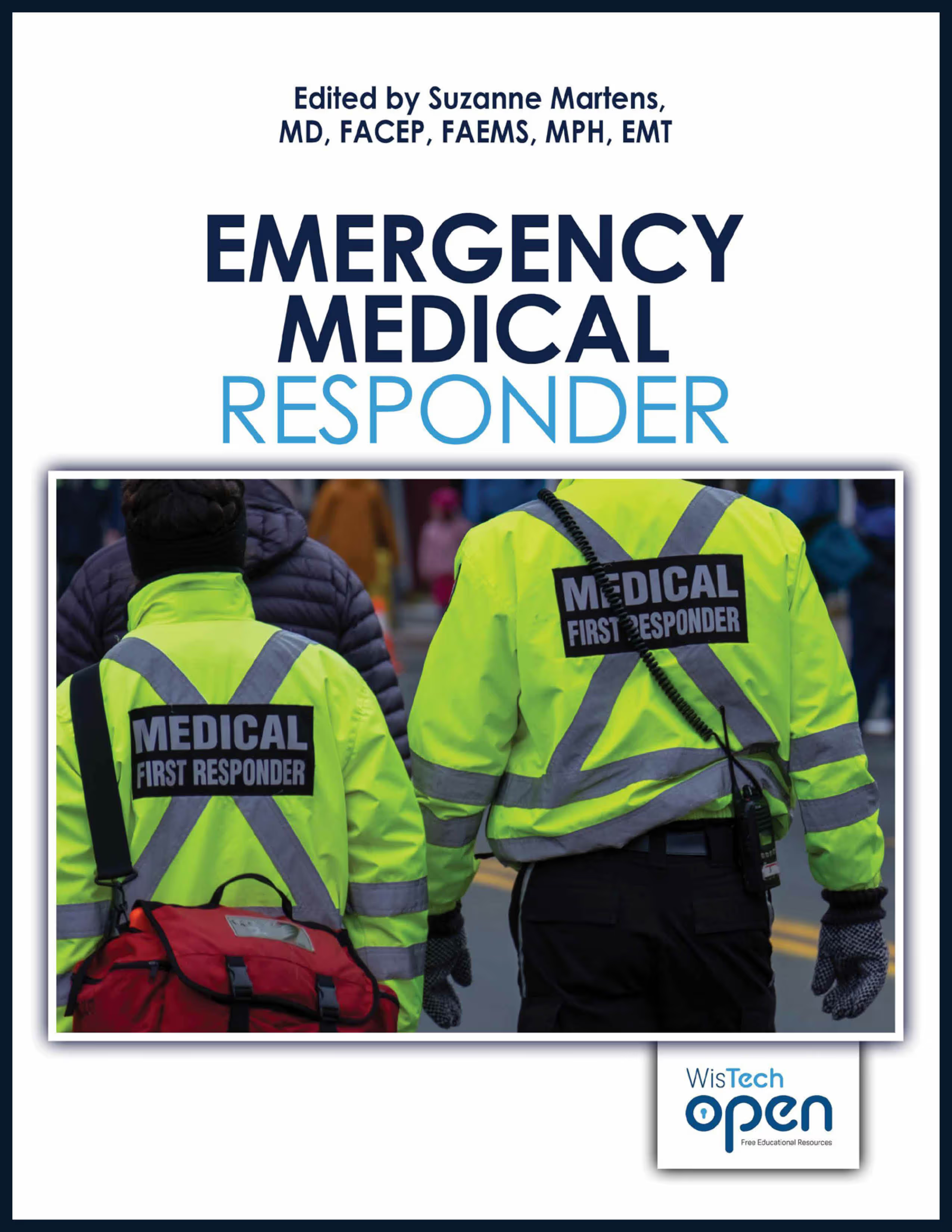Published
Estimated Publish Date
June 2025
Prepare for EMS careers with training on patient assessment, airway management, and exam readiness.
.svg)
.svg)
Print Textbook: May 2026
Audiobook: TBD
Next Edition: 2030
1,664 students | 186 high school students | $282,958 student savings
Chapter 1: Preparatory Part 1
- Identify the components of Emergency Medical Services (EMS) systems.
- Identify roles and responsibilities of the emergency medical responder (EMR) from other out-of-hospital care providers.
- Identify forms of medical oversight and discuss the EMR’s role in the process.
- Identify types of medical oversight that may affect the medical care provided by an EMR.
- Identify specific statutes and regulations in your state regarding the EMS system.
Chapter 2: Preparatory Part 2
- Identify components of communication systems.
- Describe proper radio communications between EMS providers and dispatch.
- Identify proper communication with medical direction.
- Demonstrate proper communication with receiving facilities.
- Identify attributes for increasing effectiveness and efficiency of verbal communications.
- Identify correct radio procedures for all phases of a typical call.
- Identify components of system maintenance.
- Identify considerations of phone and/or cellular communications.
Chapter 3: Medical Terminology
Learning Objectives:
- Understand commonly used medical prefixes.
- Understand commonly used medical suffixes.
- Understand commonly used root words.
- Understand commonly used directional terms.
- Understand commonly used terms associated with body systems.
Chapter 4: Anatomy and Physiology
- Describe the anatomy and function of the musculoskeletal system.
- Describe the anatomy and function of the respiratory system.
- Describe the anatomy and function of the circulatory system.
- Describe the components and function of the nervous system.
- Describe the anatomy and function of the endocrine system.
- Describe the anatomy and function of the digestive system.
- Describe the anatomy and function of the urinary system.
- Describe the anatomy and function of the immune system.
- Describe the anatomy and function of the integumentary system.
- Describe the anatomy and function of the reproductive system.
- Explain the different anatomical positions.
Chapter 5: Life Span Development
Chapter 6: Public Health
- Understand the function of Public Health Services
- Understand the support between EMS and Public Health
Chapter 7: Pharmacology
- Understand safe medication administration.
- Identify and understand medications within the EMR scope of practice.
- Determine appropriate indications and contraindications for use.
- Recognize and address polypharmacy risks.
Chapter 8: Airway Management, Respiration and Ventilation
- Identify airway anatomy and physiology.
- Identify airway assessment.
- Identify airway maneuvers.
- Identify airway adjuncts.
- Identify relief of airway obstruction
- Identify non-visualized airway.
Chapter 9: Assessment
Chapter 10: Medicine Part 1
Chapter 11: Medicine Part 2
Chapter 12: Medicine Part 3
Chapter 13: Shock and Resuscitation
- Define shock.
- Review anatomy and physiology.
- Identify disruptions that can cause shock.
- Differentiate the categories of shock.
- Describe shock due to fluid loss.
- Describe shock due to pump failure.
- Describe shock due to container failure.
- Discuss key components of patient assessment for shock.
- Describe and demonstrate the steps to follow in the emergency care of the patient with various types of shock.
- Identify age-related variations.
Chapter 14: Trauma Part 1
Chapter 15: Trauma Part 2
Chapter 16: Special Patient Populations
Chapter 17: EMS Operations
- Describe safety precautions to be taken while working at scenes on and near roadways.
- Describe the major phases of an ambulance call and the EMR’s responsibilities during each phase
- Describe post-run actions that should be taken to reduce the spread of infection
- Describe privileges afforded to responders operating emergency vehicles and the precautions that must be observed
- Describe appropriate use of emergency warning devices
You are free to:
– Share — copy and redistribute the material in any medium or format
– Adapt — remix, transform, and build upon the material for any purpose, even commercially
Under the following terms:
– Attribution — You must give appropriate credit to WisTech Open, provide a link to the license, and indicate if changes were made. You may do so in any reasonable manner, but not in any way that suggests WisTech Open endorses you or your use.
License: https://creativecommons.org/licenses/by/4.0/
WisTech Open, including the Open RN and Bright Beginnings series, does not provide ancillary or instructor materials. You can instead create free, customized resources—slides, quizzes, worksheets, study guides, and more—through our AI platform, WisTech Fusion: https://www.wistechopen.org/wistech-fusion
To help keep print textbook costs low for our students, please consider using an electronic version or purchasing a personal print copy rather than using the publisher/desktop version.

